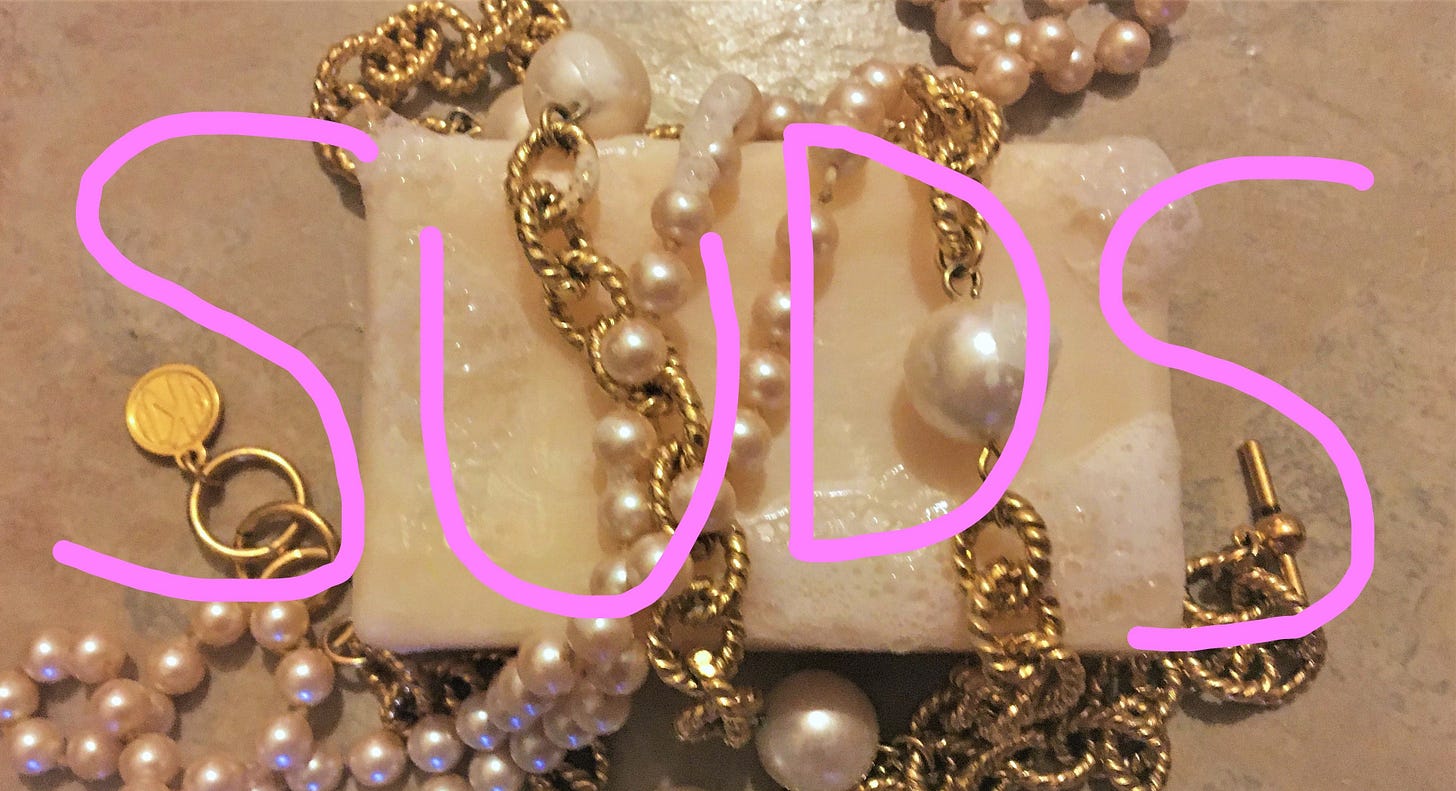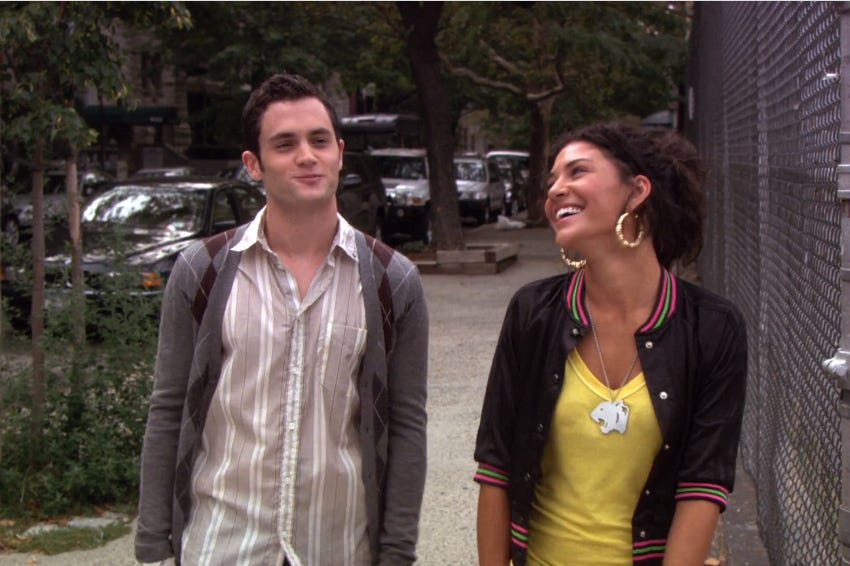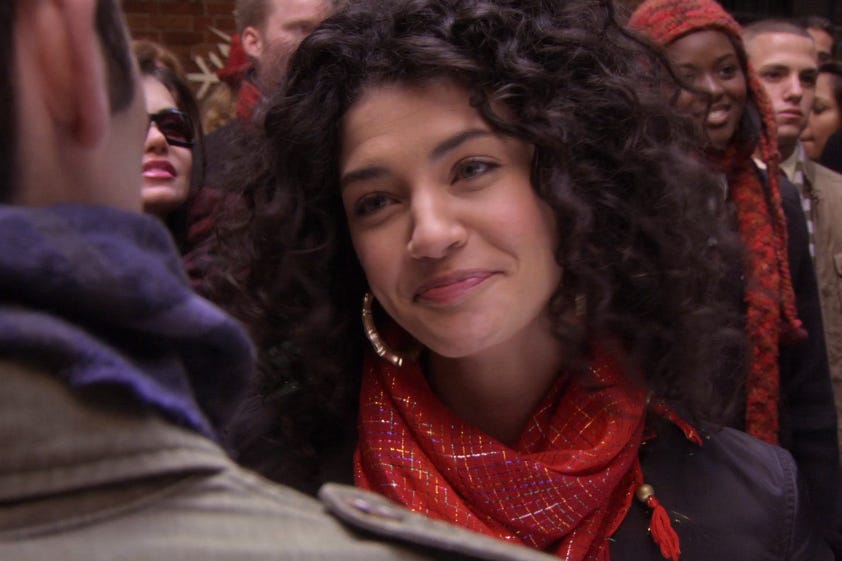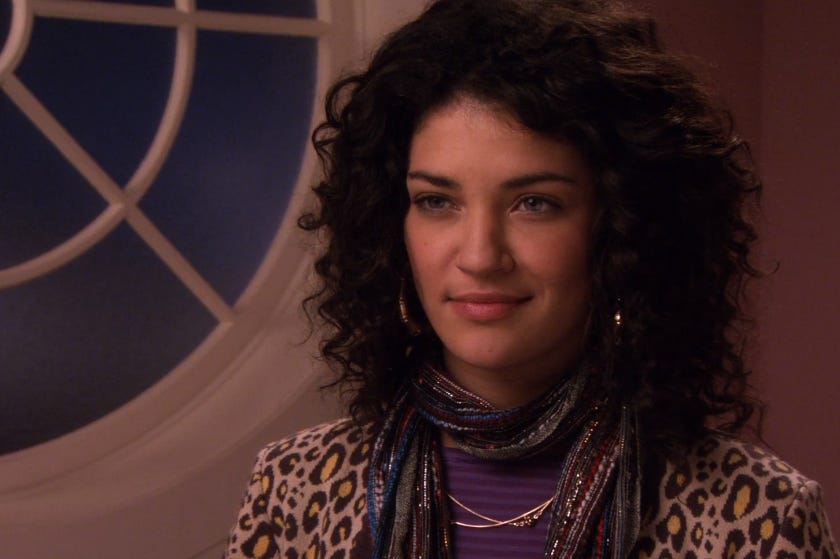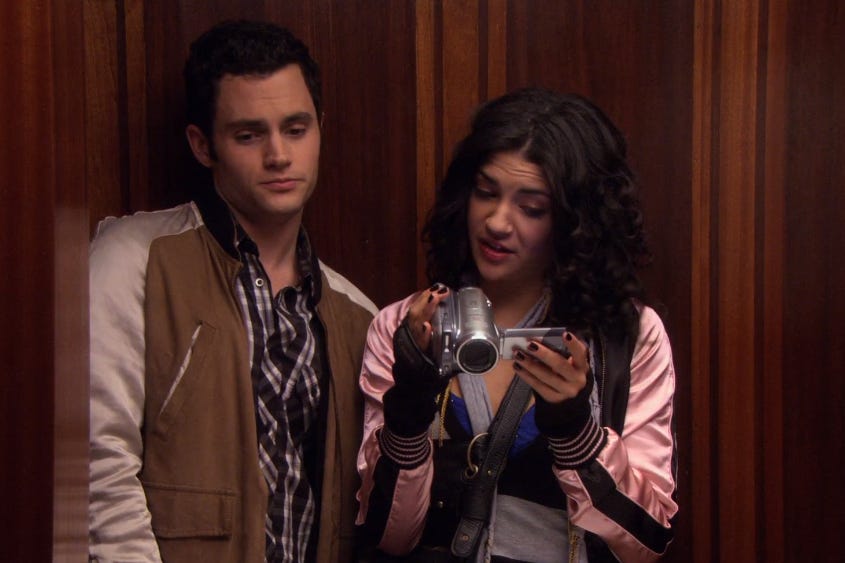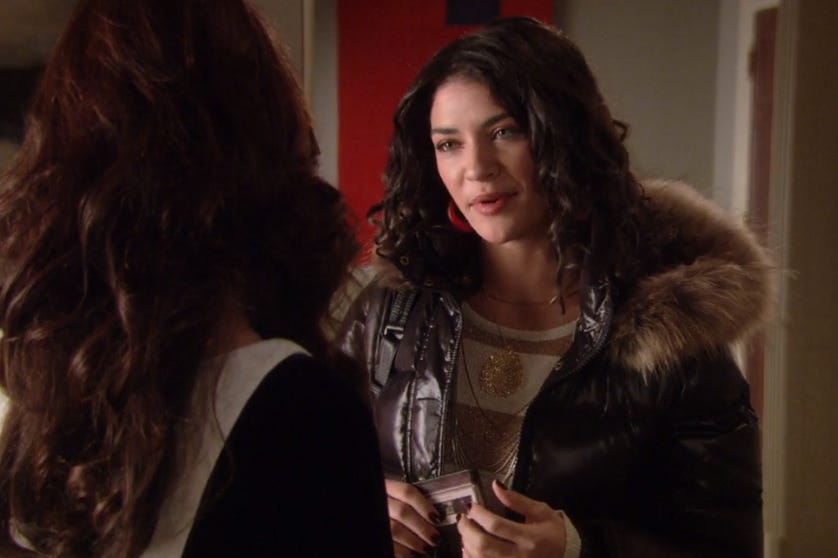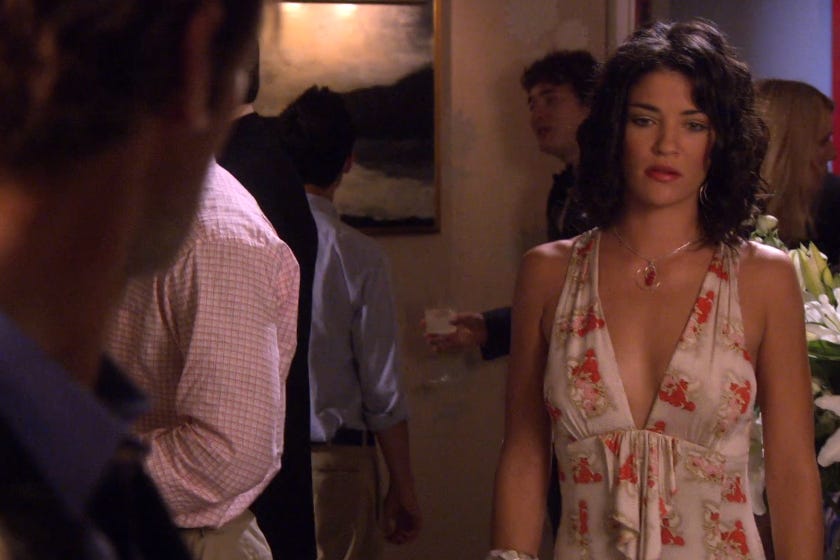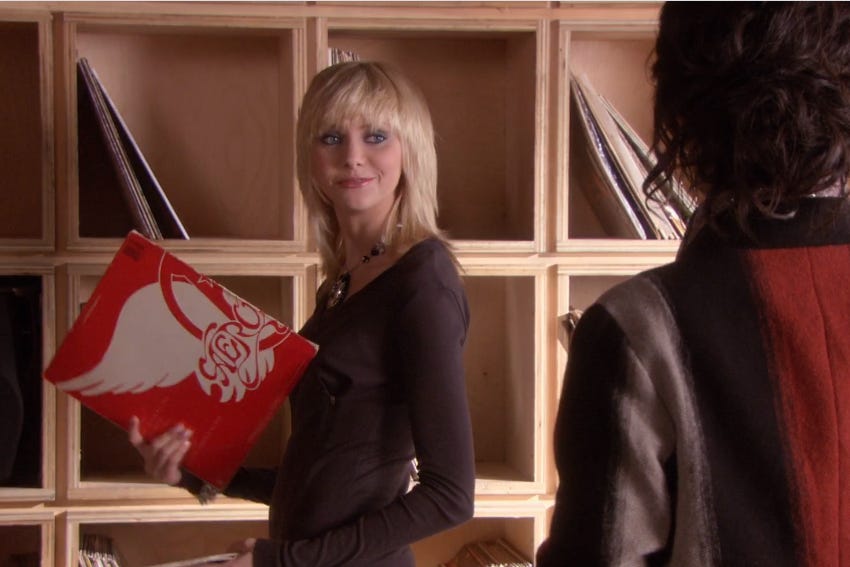A few weeks ago, I ended my comparison of Gossip Girl book and show fashion with a breakdown of Book Vanessa Abrams, a black turtleneck–clad, white-coded character—literally miles from TV Vanessa, the role that Jessica Szohr assumed in season one, episode six. Not long after her debut, New York magazine caught up with Szohr, and she explained TV Vanessa’s new style:
In the book, Vanessa was very gothic, always in black, with piercings and when we started the show, they wanted to make her kind of Lower East Side . . . tight skinny jeans, high-tops, and things like that. . . . I had just moved here so I wasn’t aware of the neighborhoods, so when I was doing homework for my character, I went to the Lower East Side (New York).
When interviewed by Vanity Fair the following year, costume designer Eric Daman and assistant costume designer Meredith Markworth-Pollack also mentioned the neighborhood:
Vanessa is a breath of fresh air. She’s the Lower East Side, Raising Victor Vargas home-girl. One night we saw M.I.A. in concert wearing a sequin sailor suit and were like “Omigod, she is so Vanessa” (Vanity Fair).
What no one seems to add, however, is that Vanessa has no connection to the Lower East Side. In 1.6, Vanessa moves back to Williamsburg, Brooklyn, to live with her sister. Before that, she spent at least a year living with her artist-activist parents in Vermont. She’s homeschooled, much of her time dedicated to working at a local coffee shop and making documentaries. In seasons three and four, she attends NYU.
None of this, again, is “Lower East Side.”
I located only one reference to Brooklyn in discussion of her costume design, an interview with Daman following the season three premiere:
Vanessa crosses the bridge to Manhattan [to attend NYU], and so will her wardrobe. Gone are the Brooklyn barista and hip-hop fashions of seasons past. We will see a more refined adult and fashion-forward Vanessa than ever before. [She’ll be] retaining her cool, eclectic vibe, but taking it to the next level with some new designer duds, statement necklaces, and bright ethnic prints (Elle).
I’m throwing these quotes up-front because honestly, I couldn’t find much else on Vanessa’s costume design from Szohr and Daman. All my usual sources were fruitless: Vanessa goes unmentioned in the season one extra “Gossip Girl Couture,” despite having been promoted to a series regular before the end of the season. She’s also absent from the season five extra “5 Years of Iconic Style”; by that point, she was no longer a regular on the show.
In 2010, circa season three, Daman collaborated with Grazia UK and Miss Selfridge, pulling together outfits for the female characters. I dug up only the introduction and Blair Waldorf’s video, but the title cards at the beginning say everything: Blair? Classic. Serena van der Woodsen? Effortless. Jenny Humphrey? Rocker.
Vanessa? Tribal.
Because here’s the thing: While the white characters’ costume design encompasses their personalities, their interests, Vanessa’s costume design centers her race, her otherness; coded in vague yet pointed terms: “tribal,” “ethnic,” “cool,” “hip-hop,” “home-girl.” Despite living in Williamsburg, Vanessa is grounded in the Lower East Side—a historically immigrant, working-class neighborhood—and the LES-set movie Raising Victor Vargas, which follows a Dominican American family. The costume designers even mention rapper M.I.A. as a style influence—as if to shout, “Not white, not white, not white!” That’s not to say that there aren’t women of color who dress like Vanessa but rather to ask why white costume designers felt they had to completely rework her costume design when descriptions of the character’s wardrobe already existed.
Szohr herself is “Hungarian and a quarter Black” and is “often asked, ‘What are you exactly?’” (People). It’s a loaded question the show never attempts to answer, and so Vanessa is fated, through her plotlines and costume design, to be ambiguously “other,” dressed in a mix of prints and jewelry from various cultures, never rooted in specificity. The only confirmations that the show even knows that Vanessa is Black are the microaggressions from white characters and the casting of her mother as Gina Torres, an Afro-Latina actress. Her father and sister, I should note, never appear.
Now, I don’t know which decision came first—whether the producers cast Szohr and then attempted to rewrite the character, or decided that Vanessa should be a teen of color and cast Szohr from there. Either way, the show, largely written and costume designed by white people, seemed unprepared to support a character and actress of color. By introducing Vanessa in episode six, the writers already put her at a disadvantage with the viewers. In the book, Serena is the interloper in Vanessa’s longtime love for Dan Humphrey, while on the show, Vanessa is barging her way into Dan and Serena’s budding romance. Remember that New York interview with Szohr? The interviewer spends half the article worried that Vanessa is going to steal Dan from Serena.
From there, her story lines only got more frustrating, and viewers responded accordingly: When you search “Vanessa Abrams” on YouTube, one of the first results is an eleven-year-old video called “Reasons why we hate Vanessa,” with more than three hundred thousand views; when you google “Vanessa Abrams,” the search bar fills in “worst character.”
To be fair, Vanessa can be rude, annoying, and hypocritical, but so can literally every other character on this show. Throughout the series, Blair, Serena, and Jenny all say terrible things and make selfish decisions; none of them became the subject of hate searches or videos explaining why “we” hate them. After all, those characters were all well-off and white, and I’m inclined to think the poor storytelling and outsized hatred surrounding Vanessa were rooted in classism and especially racism: 1) The white showrunners and writers lacked the care to craft this character, and 2) many viewers had no ability or desire to recognize or understand that inadequacy. Fans identified more with Serena, and Jenny, and particularly Blair, and so Vanessa became a threat to their favorites’ happiness: “taking” Dan from Serena, Nate Archibald from Jenny, or Chuck Bass from Blair. The queen herself, Blair, almost always treated Vanessa with hostility and disgust, and some viewers seemed happy to follow along.
Vanessa’s costume design, too, played a role in her reception. Next to Blair’s Audrey Hepburn cosplay and Serena’s model-off-duty looks—all designer—Vanessa’s fashions only reinforced her otherness: As Jillian Hernandez writes in her excellent book Aesthetics of Excess, “the styles of working-class Black and Latina women and girls generate cultural and material capital when appropriated in art and media, while drawing mockery and censure in everyday contexts” (17). Mixing prints from various cultures and layering piles of jewelry is “fun” and “adventurous” on, for example, an older rich white woman like Iris Apfel but “too much” on a Black teen girl like Vanessa.
It’s no surprise, then, that Szohr left the show at the end of season four, saying:
When I started the fourth season, I kind of had a talk with the producers. . . . We didn’t know what we were going to do with the characters. After playing someone for four years, it can be a little repetitive. So I was ready for a change. . . . I had so much fun and I made friends I’ll have for a lifetime and it was so great to work in the city, but I got the most I could out of Vanessa (E!).
Szohr’s explanation of her departure is much more gracious than my interpretation: The showrunners had run out of what little ideas they had for Vanessa, and Szohr was tired of acting those same ideas over and over. Tired, I imagine, of playing only stories that orbited and interfered with those of the white characters, her costumes changing to fit into their world. While Blair and Serena and Jenny all had plotlines about their career ambitions—magazine editing and Hollywood producing and fashion designing—Vanessa’s filmmaking almost always centered on the other characters’ private schools, recording them at an illicit pool party or a performance of The Age of Innocence. She was there to document them, to be the “Lower East Side” to their Upper East Side, the outsider looking in. It’s no wonder that, by season four, that’s all she’s reduced to: an “outsider,” and always will be.
Season One
Let’s go back to Vanessa’s first look. She and Dan have been friends since childhood, and so she reappears in his life the same way she’s always visited: climbs up his fire escape and into his bedroom. Before Vanessa moved to Vermont, Dan told her he loved her, and now that she’s back, she wants to return his affections. Little does she know, Dan just started dating his other long-term crush, Serena.
Her first outfit includes many of the pieces that will become her season one signatures: varsity jacket, T-shirt, skinny jeans, gold hoops, high-top sneakers, all topped with a wild cat–shaped pendant necklace. As Daman discussed, the pieces are hip-hop inspired—though the color choices add another layer of meaning. As I’ll explore in Serena’s profile, Serena’s signature colors are gold and its little cousin, yellow—both of which Vanessa is wearing in this scene. She’s already being presented as a threat to the show’s golden girl, Serena.
Dan and Vanessa plan to see a movie at the Angelika, Vanessa hoping to confess her feelings before or after. She changes outfits for the date: silver hoodie, snakeskin-print dress, pleather leggings, heels, and silver jewelry. Unfortunately for Vanessa, Dan cancels to surprise Serena at the masquerade ball. Vanessa helps Dan’s little sister, Jenny, get ready for the ball instead and runs into Dan and Serena there. Vanessa suddenly realizes she’s the second choice—outfitted in silver, not gold.
The next episode, Vanessa again climbs through Dan’s window . . . while Dan and Serena are trying to have sex for the first time. She wears the same gold hoops from 1.6, paired with a yellow tank, crocheted shrug, gray skinny jeans, brown boots, and layered necklaces. Dan quickly escorts her to the front door; she returns later to find him alone watching porn and offers him some sex advice: “But if it were me with you . . . I’d want you to hide [your Cabbage Patch kid], maybe get some candles, and replace the football sheets.” It’s a heavy moment, weighted with their history and unconsummated feelings. Naturally, Vanessa is back in gold and yellow.
The following morning (1.8), Dan and Serena grab breakfast at a Williamsburg café where Vanessa now works, and Vanessa awkwardly (and incorrectly) implies that they had sex the previous night. With her apron, Vanessa wears a graffiti-heart-print shirt, light-wash jeans, gold necklaces, and orange earrings. Serena has thrown on Dan’s gray argyle cardigan, her own heart a subtle gold charm around her neck, rather than a burst of colorful ones. Vanessa’s feelings are too big, too bright, too much.
Dan wants Vanessa and Serena to get along, so he brings Vanessa to Serena’s best friend Blair’s birthday party. There, Vanessa and Serena bond over Guitar Hero, Vanessa having changed into a snakeskin-print dress and cropped leather jacket, a little more in line with Serena’s style. Blair sizes up Vanessa, then turns to Serena: “Oh, sweetie,” Blair says, “you did not tell me she looked like that. This is such a problem.” Implying, certainly, that Dan shouldn’t be friends with a beautiful girl, but also, perhaps, a beautiful Black girl.
Cut to Christmas (1.11), and Vanessa has given Dan the “best present ever”: publication in The New Yorker’s “20 Under 20” issue. To deliver the good news, she chooses a black leather jacket, her gold hoops, and an orange scarf interwoven with gold thread. The scarf ties her to Dan, wearing his own plaid one, while the gold lifts her above Serena.
Serena, after all, has no idea what to get Dan for Christmas—he neither wants material things nor has an unlimited budget to buy them. Vanessa offers her expertise, but Serena turns her down—Vanessa wearing a leopard-print sweater, purple striped shirt, gray jeans, gold hoops, and gold chains.
Later that day, Serena admits defeat, and Vanessa helps her pull together a video installation of the one thing Dan does want for Christmas: snow. As they work, Vanessa wears the same outfit but with another scarf thrown on top—again, threaded with gold, much like the one she wore to give her own present to Dan. Blair, like a bloodhound, smells Vanessa’s unresolved feelings and pulls her aside: “I think you like Dan a little too much.” Vanessa quickly leaves, put into place by Blair.
After the holidays (1.12), Vanessa begins filming a documentary on the world of Upper East Side private schools, hoping to receive a local arts grant. She accompanies Dan to an after-hours pool party on school grounds, where a student hits his head and almost drowns. The attending students are assigned ten-thousand-word essays as punishment, and the initiating student is promised expulsion if found.
Blair throws an essay-writing party at her penthouse, and Vanessa, again, attends with Dan, camcorder in hand. There, she gets footage of Blair and Chuck talking about Blair losing her virginity to Chuck and faking it for her on-and-off boyfriend, Nate. Vanessa’s dressed in a pink-and-black varsity jacket, Dan in a similar jacket in neutral colors. Of the main characters, only Vanessa and Dan seem interested in the offending student receiving punishment, and so they are linked by their school-like jackets.
Both Blair and Chuck want Vanessa’s footage—Blair threatening revenge, Chuck waving a wad of bills. “I know girls like you,” Chuck tells Vanessa as she films outside Constance Billard. “You act like money’s not important, but the truth is, money’s important to everyone. . . . I know this much cash can make a real difference in your life.” Vanessa accepts his money and hands him a tape; unbeknownst to Chuck and the viewer, it’s mostly blank.
In this scene, Vanessa wears a black puffer jacket, its hood lined with fur—inspired, likely, by the jackets hip-hop artists and rappers wore in the nineties. It’s also easily the most practical coat in the show’s history. Unlike Blair or Serena, Vanessa doesn’t walk ten feet to a warm waiting car; she hauls herself to the 6 train like everyone else.
Later that day, Vanessa gives the real tape to Blair; it’s the “decent thing to do,” she says. Her puffer is unzipped even farther, revealing more of what’s underneath: shimmery striped sweater, jeans, gold pendant necklace, and orange earrings; in sharp contrast with Blair’s tuxedo-inspired dress and white tights. To call them even, Blair pays Vanessa’s rent for a year, and they briefly bond over Vanessa’s use of Chuck’s money; she established a “medical grant for teens with genital herpes in his name.”
Still, Vanessa remains rightly suspicious of the Upper East Side—including Nate, Blair’s now ex-boyfriend. In episode 1.15, Nate drops off his old SAT prep books for Dan; Vanessa rankles at the “hand-me-downs,” telling Nate that she’s already a “fine tutor” for her friend.
After finding one of Nate’s practice essays tucked in a book, she softens and invites him to a local diner to apologize. In both scenes, she wears blouses—one, a cream printed top with little buttons on one shoulder; the other, a yellow pleated blouse, paired with a leather jacket and gold star necklace. The pieces are softer yet more formal than those we’ve previously seen on Vanessa—styles that Blair or Jenny, Nate’s other love interests, would wear. Nate and Vanessa spend the rest of the day getting to know each other and kiss at the end of the night.
Vanessa isn’t planning to take the SATs herself; her parents and sister are artists and never went to college. Nate convinces her to keep her options open, surprising her by taking her to an exam. When Nate picks her up, she’s dressed in a striped purple shirt, gray hoodie, leather bomber, denim mini, and bright pink Docs. The shirt reminds us of the first time she wore it—when Blair told her that she liked Dan “too much”—but also echoes Nate’s own striped button-down. Vanessa’s feelings for Dan are fading while her feelings for Nate are growing.
In the season finale, Nate brings Vanessa as his date to a wedding. Jenny makes her an orange floral dress, and Vanessa pairs it with turquoise jewelry and an orange fake day lily in her hair. The lily and florals are likely a nod to the bride herself, Lily van der Woodsen; both Blair and Serena are also dressed in floral prints and fake flowers, though theirs are designer. Vanessa is learning to dress for the Upper East Side, but even the right outfit can’t save her relationship with Nate or prevent Blair from making nasty comments at the reception.
Unlike Chuck and Blair, whose pinks perfectly pair, Vanessa and Nate are dressed in completely different color palettes and styles, Nate all business in a navy pinstriped suit, checked shirt, and pale yellow tie. Nate has “too much going on” for a relationship—his father has just run away to Dominica to escape a prison sentence.
Season Two
Vanessa spends the summer creating a café in Rufus Humphrey’s Williamsburg art gallery. When Rufus arrives home from his band’s tour (2.2), she shows off her handiwork, dressed in a neon yellow off-the-shoulder blouse, matching earrings, and two necklaces: one, a gold heart; the other, a gold key. With time, the colors yellow and gold have become independent of Serena and Dan, symbolic only of herself.
Nate soon visits the new café to confide in Vanessa: his family’s assets have been seized as restitution for his father’s crimes and his grandfather has cut them off. But unbeknownst to Vanessa, Nate has also confided in his secret summer fling: an older married woman named Catherine.
Nate promises to return later that evening but can’t keep their date; Catherine has offered him money to continue their relationship. Since she knows his father’s whereabouts, he can’t turn her down. Vanessa waits for Nate at the café, dressed up in a striped strapless dress, wedges, and two necklaces. The stripes call back to the shirt she wore at the beginning of their relationship, but gone are the heart and key charms from earlier in the day. Nate has the key to her heart, yet it remains unturned.
Despite his agreement with Catherine, Nate can’t give up on Vanessa. The next episode, they make plans to hang out, Vanessa happy in a bright striped top and matching earrings and necklace—unusual for Vanessa, who almost always favors mismatched jewelry.
In fact, the more time she spends with Nate, the more her wardrobe shifts: smaller, simpler jewelry; softer, sweeter dresses and tops, much like the printed blouses she wore in season one. Take, for example, this pale-yellow-and-lavender dress, paired with a minimalist gold necklace and earrings, belt, and heels. All the markers of her style are still there, just muted, matching. She’s dressing to blend into his Upper East Side world, to be more like the girl she thinks Nate would date.
Blair invites Vanessa to her back-to-school party—which, of course, Catherine is also attending. For the occasion, Vanessa picks an orange-and-white-floral halter dress and an orange necklace. Again, she’s chosen a simpler version of her usual look, in the color she wore the last time she and Nate broke up. Because at the party, they do again: Vanessa tells a confused Nate to stay with Catherine; she can’t tell him that Catherine threatened to rat out his father’s whereabouts if Vanessa didn’t remove herself from their love triangle.
In the next episode, Vanessa returns to her usual statement jewelry and color mixing as she tries to avoid Nate. Armed with another of Catherine’s secrets, Vanessa asks Blair for help with blackmail. But when Vanessa becomes convinced that Blair isn’t following through, she tells Catherine’s husband about the affair and disrupts Blair’s carefully laid plan. Once Nate finds out, he and Vanessa are officially over—not because Blair’s scheme was ruined but because Vanessa never told Nate what she was trying to do. In this scene, Vanessa wears a sheer black-and-purple blouse, subtle gold stripes running through it; purple woven earrings; an orange beaded necklace; and teal jeans. She’s done with dressing for Nate’s world, at least for a couple episodes.
Vanessa, the show sometimes remembers, is a community activist; by episode seven, we finally see some real activist-y work: Vanessa blackmails Blair into collecting signatures for a Brooklyn bar’s landmark status.
As revenge, Blair convinces Chuck to seduce and humiliate Vanessa. He feigns interest in buying the bar, but his act turns sincere as he learns more about its history and spends time with its owner, Horace, a magical Black man there to give Chuck some humanity while bluesy music plays in the background.
At the Bass housewarming, Blair reveals their game to Vanessa—worried, perhaps, that Chuck is becoming too close to his target; threatened, certainly, that Chuck is showing a piece of the “real” him to a girl like Vanessa. Their love triangle manifests in their party outfits: Blair in burgundy, Vanessa in gray, and Chuck in shades of both. Again, Vanessa has simplified her wardrobe for an Upper East Side occasion, this time pairing a gray print dress with a tiered blue necklace and hoops.
Nate’s affections turn to Jenny while he’s living with the Humphreys; they kiss but never quite date, though Nate sends her a love letter after he moves out of the Humphrey loft. Vanessa, naturally, is hurt by Nate’s easily transferred interest and Jenny’s disregard for their friendship.
So in episode eleven, when Vanessa is presented with the opportunity to reunite with Nate, she takes it, stealing Nate’s letter before Jenny can read it. Throughout the episode, Vanessa wears an orange peacoat—the bright color reminding us of her previous breakups with Nate, but the silhouette hinting at their future. A peacoat is a preppy staple, often worn by Nate himself in navy blue. Remember it; we’ll come back to the coat later.
Bubble Episode
For Vanessa’s profile, I knew my deep dive would be into 2.12, “It’s a Wonderful Lie”: an episode that illustrates not only how Vanessa’s style changes during her relationship with Nate but also how the show treats the bodies of its Black female characters.
At the beginning of the episode, Vanessa visits the loft, where Jenny is reorganizing Rufus’s record collection by genre—an attempt to distract herself from “thinking about what happened with Nate.” Vanessa nervously plays with the ends of her scarf and suggests that Jenny “move on”; she hasn’t told her friend that she’s dating Nate again. The grays in her striped bomber tie her to Jenny’s gray sweater dress, while the silver threads in her scarf call back to other metallic scarves that she’s worn: specifically, the gold-woven scarves from the same time last year, when she helped Serena with Dan’s present. Again, she isn’t being honest about her feelings, but this time, her chosen metal is Jenny’s silver, rather than Serena’s gold.
Vanessa leaves to meet Nate on the Upper East Side. There, he asks her to the Snowflake Ball, but she doesn’t think it’s a “very good idea right now”—“right now” being while Jenny doesn’t know. Her guilt fresh from her conversation at the loft, she asks Nate what he would do if Jenny still liked him. He brushes the question aside, and they kiss—captured, inevitably, by a passerby, who sends the photo to Gossip Girl.
In the meantime, Jenny agrees to make a custom Snowflake Ball dress for one of Blair’s minions, Penelope. While in their fitting, they both see Gossip Girl’s blast: “Spotted: N swapping spit with a girl from an outer borough. Ew. Ew. Ew.” Vanessa doesn’t even get a name; she’s just “a girl from an outer borough”—not rich or white or ours.
Vanessa returns to the loft, unaware of the post until Jenny confronts her. She apologizes, but their conversation quickly turns into a fight over who stole Nate first. Vanessa storms out, declaring she will go to the Snowflake Ball with Nate.
Later that day, Jenny brings the custom dress to Penelope’s apartment, where Penelope and her fellow minions, Hazel and Iz, are plotting revenge on Vanessa for “fishing in [their] pond.” Iz reveals her Snowflake Ball dress—and when she stands in front of the light, it reveals a lot of her, too. The one-shouldered shimmery silver gown is unlined, and we’re given a long shot of Iz’s legs and underwear through the fabric. The minions’ revenge is now clear: Jenny will pretend the gown is her own creation and gift it to Vanessa for the ball.
The next day, Jenny does just that: brings the dress to the gallery café and tells Vanessa she was “up half the night making [it] before [she] realized who it was for.” Again, they are linked by shades of gray and silver: Vanessa in a rectangle-printed sweater and silver hoops, Jenny in a gray sweater and moto jacket and silver chains.
Touched by Jenny’s “peace offering,” Vanessa attempts to confess the stolen letter, but she’s cut off by her phone ringing—Nate calling. Jenny quickly leaves, telling Vanessa she doesn’t “want to know”—likely because she doesn’t want to hear anything that might sway her from revenge.
Vanessa wears the silver gown to the ball, paired with her jewelry from the café and, outside, a plain gray shawl. Her choices are simple, little planned—in line with the more basic styles Vanessa favors while dating Nate, but also indicative of her sole mission at the ball. As she tells Jenny when she arrives, she is “ending things with Nate.”
Jenny herself is fully done up: a black gown and cape, silver and gunmetal chain necklaces, her usual heavy eyeliner. Among the soft pastels, whites, and metallics of the other attendees, she stands out, almost witchlike, ominous.
Vanessa finds Nate and reveals that she stole his letter. “I’ve never felt this way about anyone before, never,” she says, “and it made me do something that I can’t believe I did.” As she walks away, fighting tears, the minions turn a spotlight on her. Jenny tries to get to her first, but she’s too late: Vanessa’s gown is suddenly see-through in front of the entire ball, the hall echoing with laughter and calls of “Nice dress.” The camera pans up Vanessa’s legs to her underwear.
Aside from Vanessa, Iz is the only other Black recurring character, and so the show’s decision to embarrass them in the same manner, with the same lingering shots of their bodies, is disturbing. Yes, the white female characters are also subjected to long shots of their bodies in undergarments but almost always in romantic or sexual contexts: Blair waiting for Chuck in lingerie, for example. I can’t think of one instance of Blair or Serena or Jenny being disgraced by her unclothed body, while the camera simultaneously leers at said body. By costuming their two Black female characters in the same sheer dress, the show enforces the media representations of hypersexualized Black girls and women (the history of which is discussed in this article). Iz and Vanessa’s bodies are presented for the viewers’ and characters’ consumption and mocking and pleasure.
After Vanessa leaves the ball, Nate scolds Jenny and follows his date outside. “When you walked away tonight,” he tells her, “all I could think was, ‘She’s the one I want to be with.’”
This time, Vanessa cries happy tears—her consolation prize, her reward for taking her humiliation, is Nate’s affections. “You didn’t just pull a Janet Jackson at the Snowflake Ball,” she jokes.
Episode 2.12 aired only four years out from Jackson and Justin Timberlake’s halftime show, at a time when “Nipplegate” was still treated as a punch line, rather than a serious examination of the unequal punishment doled out to a Black woman (Jackson) and a white man (Timberlake). For this reason, I suspect the writers intended the joke to be just another hilarious pop culture reference, rather than an acknowledgment of a culture that vilifies Black women’s bodies, Vanessa’s and Iz’s included.
[Part two, covering the rest of season two through the series finale, will publish this evening.]



